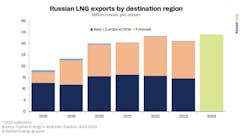Current total global recoverable oil reserves amount to 1,624 billion bbl, according to research by Rystad Energy. This number is a notable increase of 52 billion bbl compared with the firm’s 2022 estimate.
Emissions from oilfield operations are estimated at 5% of all crude-related emissions. The industry is working to reduce upstream emissions intensity, which can vary from 10 kg of carbon dioxide per bbl of oil (kgCO2/bbl) in Saudi Arabia to more than 100 kgCO2/bbl in heavy oil fields in Venezuela.
Since Rystad’s 2022 report, 30 billion bbl of crude oil have been extracted, the same level seen in 2018 and 2019, with 84 billion bbl added in fields, discoveries, and exploration prospects.
While 1,624 billion bbl of oil are technically recoverable, fewer than 1,300 billion bbl are likely to be economically viable before 2100 at an average Brent price of $50/bbl. The potential longevity of proven reserves varies widely among OPEC and non-OPEC producers, ranging from fewer than 5 years for the UK to more than 20 years for Canada. Iran leads OPEC members with almost 13 years of proven reserves.
Saudi Arabia leads the way in total recoverable oil with 271 billion bbl. The US follows with 192 billion bbl, Russia with 143 billion bbl, and Canada with 127 billion bbl. Iraq and Iran round out the top six with 107 and 88 billion bbl, respectively. China saw a significant jump from last year due to the de-risking of technically recoverable shale resources, with total reserves now estimated at 75 billion bbl. New estimates on Daqing producing fields and recent developments in Xinjiang province and in the Tarim petroleum basin have together boosted the Asian giant’s resources.
Rystad Energy estimates reserves and resources according to the widely recognized Petroleum Reserves Management System (PRMS). The PRMS standard distinguishes between three classes of likelihood (P1, P2, and P3) and three classes of development maturity (producing plus approved, discovered, and undiscovered).
Rystad’s resource assessment is as of Jan. 1, 2023.
Global warming
In a scenario where global warming is limited to 1.9°C, the recoverable oil will contribute about 0.2°C of additional warming by 2100, Rystad said. Therefore, about 20% of any additional warming will come from burning oil in cars, ships, and airplanes and all other uses that lead to greenhouse gas (GHG) emissions.
“The upstream sector is working hard to reduce greenhouse gas emissions from oilfields. However, even with these mitigation measures and governmental efforts, if global warming is to be successfully limited to 1.6°C, only half of the world’s recoverable reserves would be required. It’s not unreasonable to conclude that policies and technological advances can reduce oil consumption and boost the energy transition, bringing us closer to a 1.6°C scenario,” said Rystad chief executive officer Jarand Rystad.


